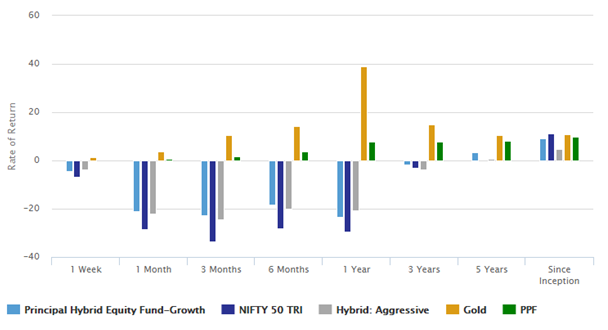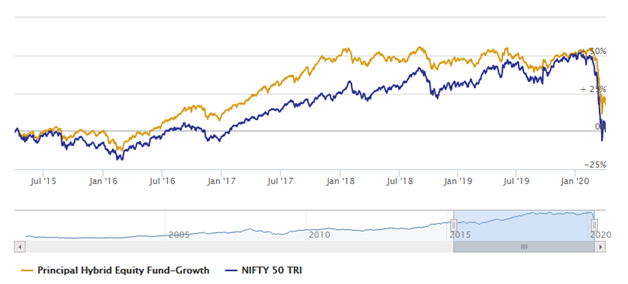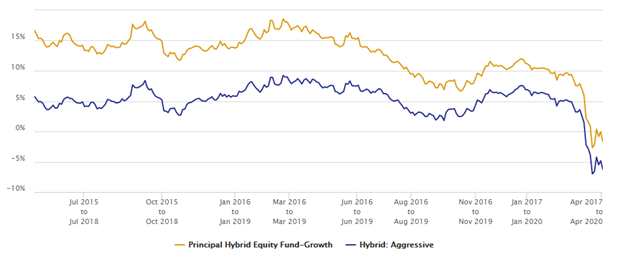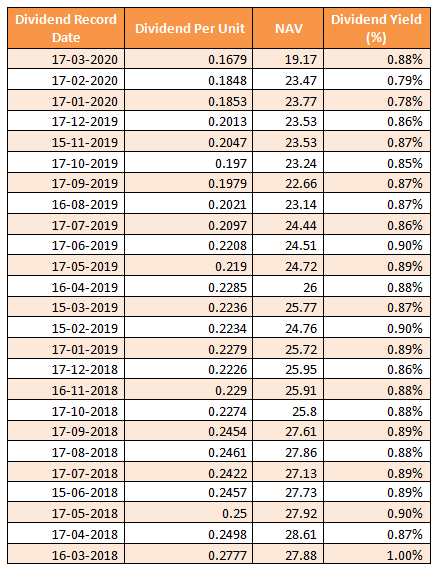Principal Hybrid Equity Fund: A good hybrid fund for long term investors

Volatile markets remind investors the importance of asset allocation in their financial planning. Asset allocation reduces portfolio volatility, limits downside risks and helps investors meet their investment objectives. Hybrid mutual funds are effective and tax efficient asset allocation solutions. These funds invest in both debt and equity securities.
There are different types of hybrid funds with different risk characteristics. Aggressive Hybrid Funds are equity oriented hybrid funds, where minimum equity allocation in these funds is 65%. Aggressive Hybrid Funds enjoy equity taxation. Long term capital gains (investment tenure of more than 1 year) up to Rs 1 Lakh are tax exempt; long term capital gains in excess of Rs 1 Lakh are taxed at 10%. Dividends paid by Hybrid Aggressive Funds are taxed as per the income tax rate of the investor.
Principal Hybrid Equity Fund is one the best performing aggressive hybrid funds in the past five years (please see the Top Performing Aggressive Hybrid Funds in our MF Research Section). The chart below shows the annualized returns of Principal Hybrid Fund versus the Aggressive Hybrid Funds category over trailing 1, 3, 5 and 10 years.
You can see that the scheme outperformed Aggressive Hybrid Funds category over most periods. You can also see that the scheme outperformed Nifty in the last 5 years. Though last 1 year returns have been negative, the fall is much less than NIFTY even in the last 3 – 6 months.

Source: Advisorkhoj Research
Principal Hybrid Equity Fund, formerly known as Principal Balanced Fund, was launched in January 2000 and has around Rs 1,266 crores of Assets under Management (AUM). The expense ratio of the fund is 2.07%. Ravi Gopalakrishnan, Ashish Aggarwal and Bekxy Kuriakose are the fund managers of this scheme. The chart below shows the Net Asset Value growth of Principal Hybrid Equity Fund over the last 5 years.

Source: Advisorkhoj Research
Rolling Returns of Principal Hybrid Equity Fund
We have discussed many times in our blog that rolling returns is the best measure of mutual fund performance because it is not biased by specific market conditions like trailing and point to point returns are. The chart below shows the 3 year rolling returns of Principal Hybrid Equity Fund over the past 5 years. We have chosen a 3 year rolling returns period because investors should have at least 3 year investment tenor for investing in equity oriented hybrid funds. Over longer tenor aggressive hybrid funds can leverage the wealth creation potential of equity as an asset class.

Source: Advisorkhoj Rolling Returns Calculator
You can see that Principal Hybrid Equity Fund beaten the Aggressive Hybrid Funds category consistently over 3 year rolling periods of in the last 5 years. Outperformance consistency across different market conditions is the hallmark of well managed funds. You can see that the minimum three year annualized rolling return is just about -3% (minimum rolling return for the category -11.5%, despite the 30% fall in the market this year. This shows how well managed hybrid funds can limit downside risks for investors.
The maximum 3 year annualized rolling return of the Principal Hybrid Equity Fund was around 18.6%, whilethe maximum for the Aggressive Hybrid Funds category is 15.2%. This shows that the scheme was able to outperform Aggressive Hybrid Funds category in both good and bad market conditions.
The average 3 year annualized rolling return of the Principal Hybrid Equity Fund was 12.6%, while that of the Aggressive Hybrid Funds category was 7.5%. The median 3 year annualized rolling return of the scheme was 13.6%, while that of the category was 7.7%.
The chart below shows the 3 year rolling returns performance consistency of Principal Hybrid Equity Fund versus the Aggressive Hybrid Funds category.

Source: Advisorkhoj Rolling Returns Calculator
We can make several important inferences from the chart above –
- If you have a sufficiently long investment horizon, the possibility of making a loss in hybrid funds is low.
- Secondly, average 3 year rolling returns of Aggressive Hybrid funds was more than 8% about 43% of times, while Principal Hybrid Equity Fund gave more than 8% returns nearly 90% of the times. Investors usually expect 7 – 8% returns from fixed income.
- Principal Hybrid Equity fund beat fixed income returns 90% of the times across different market conditions.
- Principal Hybrid Equity Fund gave more than 12% returns nearly 63% of times, creating wealth for investors in the long term.
- In fact, over the last 20 years or so since inception, Principal Hybrid Equity fund gave nearly 10% CAGR return.
Asset Allocation and Portfolio Construction
The asset allocation mandate of Principal Hybrid Equity Fund as per SEBI’s category guidelines is 65% to 80% Equity; within equity there are no sub limits on market cap segments. The current asset allocation of the fund is 62% equities, 23% debt and around 15% cash or cash equivalents. The equity portion of the scheme portfolio is predominantly large cap.
The fund manager is quick to shed risk and move on tactically. The debt strategy of the Principal Hybrid Equity Fund’s portfolio is active duration management and some tactical trading positions to optimize returns. The credit quality of the debt portfolio is high. The chart below shows the top stocks and sector composition of the scheme portfolio.

Source: Advisorkhoj Research
Lump sum returns
Growth of Rs 100,000 lump sum investment in Principal Hybrid Equity Fund since inception - The scheme nearly matched Nifty returns without being nearly as volatile as Nifty. Annualized return since inception is 9.54% (as on 7th April 2020) and the investment of Rs 100,000 has grown to Rs 633,000.
SIP returns
Monthly SIP of Rs 10,000 in Principal Hybrid Equity Fund since inception has grown to Rs 84.13 Lakhs against an investment of Rs 24.30 Lakhs. Annualized SIP return (XIRR) since inception was 11%.
Dividend History
The table below shows that Principal Hybrid Equity Fund has been paying regular monthly dividends for the last 2 years. The annual dividend yield is fairly high. Investors should, however, understand that mutual fund dividends are not assured. Mutual fund dividends are paid from the accumulated profits of the schemes. Fund houses can change the dividend payout rate (dividend per unit) and / or the frequency of dividend payment at their discretion. Further, from this financial year onwards, mutual fund dividends will be added to your income and taxed as per income tax slab rate.

Conclusion
Principal Hybrid Equity Fund has completed more than 20 years. The scheme has also been a consistent performer over the past 5 years. Investors with moderately aggressive risk appetites can invest in this Fundboth in lump sum and through SIPswith a sufficient long investment horizon.
If you are worried about market volatility when making lump sum investments, you can invest your lump sum money in a Principal Mutual Fund’s liquid fund and then transfer (STP) systematically to Principal Equity Hybrid Fund over the next 3 to 6 months. Investors should consult with their financial advisors if Principal Hybrid Equity Fund is suitable for their investment needs.
Mutual Fund Investments are subject to market risk, read all scheme related documents carefully.
Queries
-
What is the benefit of mutual fund STP
Aug 29, 2019
-
How much to invest to meet target amount of Rs 2 Crores
Aug 26, 2019
-
Can I achieve my financial goals with my current mutual fund investments
Aug 24, 2019
-
Can you tell me return of various indices
Aug 19, 2019
-
What would be the post tax return on different investments
Aug 18, 2019
-
Which Principal Mutual Fund scheme will be suitable for my retirement corpus
Aug 16, 2019
-
What is the minimum holding period for availing NCD interest
Aug 4, 2019
Top Performing Mutual Funds
Recommended Reading
Fund News
-
Kotak Mahindra Mutual Fund launches Kotak Nifty Next 50 ETF
Dec 18, 2025 by Advisorkhoj Team
-
The Wealth Company Mutual Fund launches The Wealth Company Gold ETF
Dec 16, 2025 by Advisorkhoj Team
-
Axis Mutual Fund launches Axis Gold and Silver Passive FOF
Dec 10, 2025 by Advisorkhoj Team
-
Jio BlackRock Mutual Fund launches JioBlackRock Arbitrage Fund
Dec 9, 2025 by Advisorkhoj Team
-
Tata Mutual Fund launches Tata BSE Multicap Consumption 50:30:20 Index Fund
Dec 9, 2025 by Advisorkhoj Team














